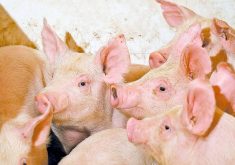Glacier FarmMedia – Livestock transportation is a heavily regulated industry and new technology should make life easier for haulers and animals.
Innovative designs are becoming more available in North America, especially for trailers designed to haul pigs and chickens, said Jeff Hill, animal welfare specialist with Wood Environment and Infrastructure Solutions.
Why it matters: Animal welfare is a significant concern for the public and better trailers can make for less stress on animals.
“There have been minimal technical advancements made in North America in the past 50 years,” he said at the recent North American Meat Institute animal welfare conference held in Kansas City, Missouri.
Read Also

Dissolving eartags could make pig traceability easier
A dissolving eartag for market hogs, called Clean Trace could reduce processing challenges and enable more individual management of pigs.
However, extensive research and development to improve animal transport has come about through collaboration between European and North American manufacturers.
The goal is to improve the comfort of the animal during the entire process from loading to transport to arrival at the final destination. The new designs are more efficient, provide more protection from the weather and help reduce disease exposure and transmission.
“Every manufacturer will tell you they have the best,” said Hill.
However, some new designs offer clear advantages.
New trailer designs provide better biosecurity because they are easier to clean. Improved air filtration and ventilation improves comfort and reduces disease transmission
Other designs incorporate lift decks rather than ramps because it is easier to load pigs. There are fewer slips and falls, as well as less need to use prods.
Another innovation is installing sensors in trailers with real-time reporting to the driver.
Insulated trailers with fully automatic mechanical ventilation are on the market but these need to be tested in extreme cold weather. These produce less dust and there is better ventilation when the vehicle is moving.
“We need to be looking at a universal animal comfort index that takes into account temperature, relative humidity, bedding, noxious gases. All of these needed to be taken in and determined at the pig’s level, not up in the ceiling or down in the belly,” he said.
Another area for improvement is working with drivers, said Courtney Lynd Daigle of Texas A & M University.
“We can make whatever laws we want but people are the wild card.”
Human behaviour contributes to animal health and welfare, she said.
Truckers in Canada and the United States work long hours and often go beyond the regulated hours of duty.
“They are under pressure to drive long periods and on irregular driving schedules,” she said.
They work long shifts and suffer from fatigue, sleep restrictions and exposure to noise and are often sedentary. Some admit to using drugs to stay awake, said Lynd.
Livestock haulers must understand livestock and their behaviour and possess good people and mechanical skills. They have to be able to load animals, as well as deal with customers who may want to load unfit livestock.
This article originally appeared at the Western Producer.












